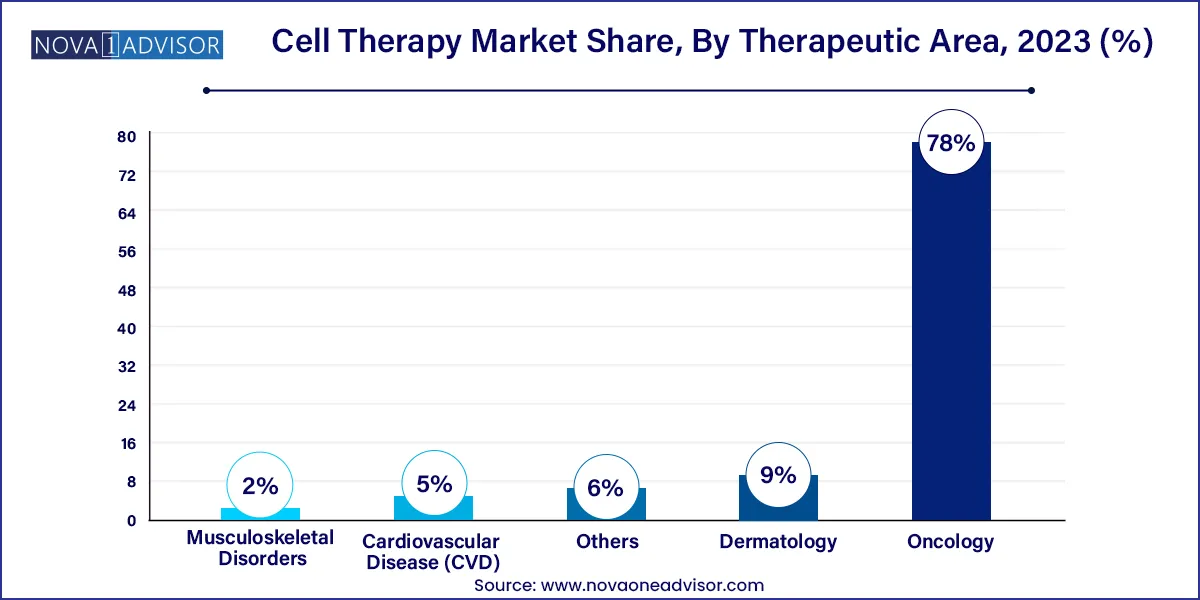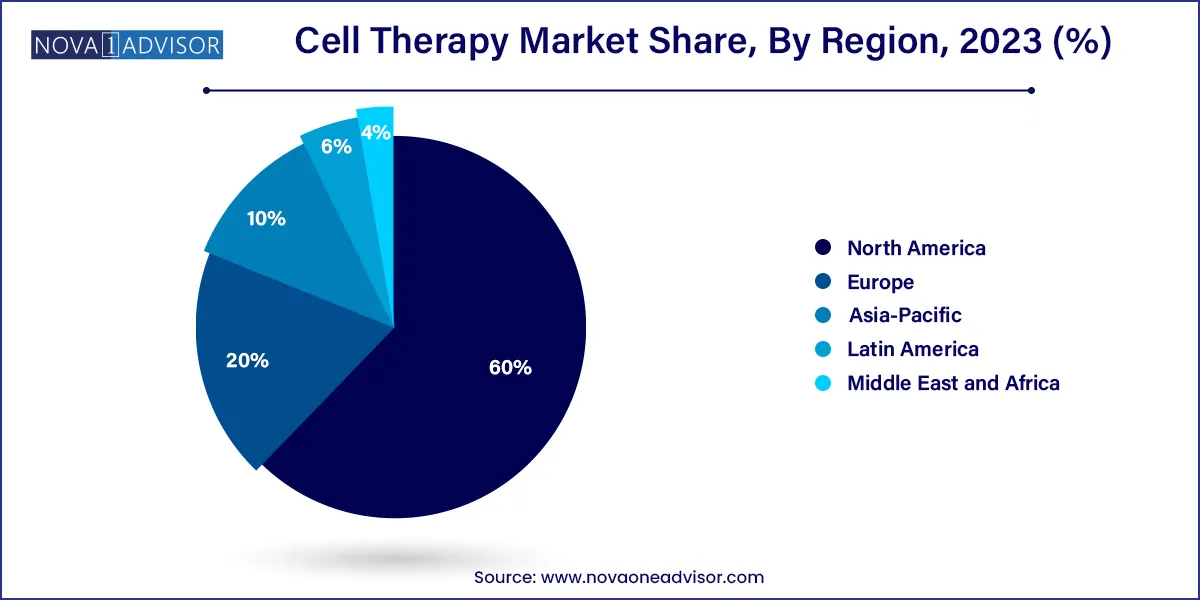The global cell therapy market size was exhibited at USD 4.85 billion in 2023 and is projected to hit around USD 37.42 billion by 2033, growing at a CAGR of 22.67% during the forecast period 2024 to 2033.
.webp)
Key Takeaways:
- North America accounted for the largest revenue share of 60.0% in 2023.
- Asia Pacific is estimated to register a significant CAGR during the forecast period
- Autologous therapy segment dominated the market with a share of 92.0% in the year 2023.
- The oncology segment dominated the overall market with the largest revenue share 78% in 2023.
Market Overview
The cell therapy market has emerged as a cornerstone of regenerative medicine, offering revolutionary treatment options for diseases previously deemed incurable. At its core, cell therapy involves the administration of living cells to repair, replace, or regenerate damaged tissues and organs. Over the past decade, cell therapies have transitioned from experimental procedures to approved treatments, particularly in oncology, orthopedics, and cardiovascular medicine.
Cell therapies are categorized into autologous and allogeneic types. Autologous cell therapies utilize a patient’s own cells, minimizing immune rejection risks, while allogeneic therapies use donor cells that can be manufactured at scale. Stem cell therapies, particularly those derived from bone marrow, adipose tissue, or umbilical cord blood, dominate the landscape due to their pluripotency and ability to differentiate into various cell types. Meanwhile, non-stem cell therapies, such as CAR-T cells and fibroblast-based treatments, have gained prominence in oncology and dermatology, respectively.
The global market is driven by a growing burden of chronic diseases, aging populations, increased investment in biotechnology, and favorable regulatory environments. Governments and private players are pouring resources into R&D, infrastructure development, and clinical trials, laying a robust foundation for market expansion. As of 2024, hundreds of cell therapy candidates are undergoing clinical evaluation worldwide.
Major Trends in the Market
-
Surge in CAR-T and TCR-based therapies for hematological malignancies and solid tumors.
-
Technological advancements in stem cell culturing, expansion, and cryopreservation.
-
Development of universal donor cells to enhance scalability and affordability.
-
Increasing partnerships between pharmaceutical companies and cell therapy startups.
-
Rise of decentralized and point-of-care manufacturing models.
-
Integration of artificial intelligence in cell selection, potency analysis, and therapy personalization.
-
Growing government support for regenerative medicine through funding and streamlined regulations.
-
Emergence of cell therapy in treating autoimmune and rare genetic disorders.
-
Investment in off-the-shelf allogeneic therapies with enhanced immunotolerance.
Cell Therapy Market Report Scope
| Report Coverage |
Details |
| Market Size in 2024 |
USD 5.95 Billion |
| Market Size by 2033 |
USD 37.42 Billion |
| Growth Rate From 2024 to 2033 |
CAGR of 22.67% |
| Base Year |
2023 |
| Forecast Period |
2024-2033 |
| Segments Covered |
Therapy Type, Therapeutic Area, Region |
| Market Analysis (Terms Used) |
Value (US$ Million/Billion) or (Volume/Units) |
| Regional Scope |
North America; Europe; Asia Pacific; Central and South America; the Middle East and Africa |
| Key Companies Profiled |
Novartis AG; Gilead Sciences, Inc.; Bristol-Myers Squibb Company; Johnson & Johnson Services, Inc; JCR Pharmaceuticals Co., Ltd.; JW Therapeutics; Atara Biotherapeutics; Anterogen Co., Ltd.; MEDIPOST; S. BIOMEDICS |
Key Market Driver: Expanding Applications Across Therapeutic Areas
One of the strongest drivers of the cell therapy market is the expanding scope of applications across multiple therapeutic areas. Initially limited to hematologic cancers and orthopedic injuries, cell therapies are now being explored and adopted in cardiovascular disease, dermatology, neurodegenerative disorders, autoimmune diseases, and even metabolic conditions.
For example, stem cell therapy has shown promise in regenerating cardiac tissue post-myocardial infarction. In dermatology, fibroblast-based therapies are being used to treat burns, chronic wounds, and scars. Meanwhile, T-cell therapies like CAR-T have revolutionized oncology by achieving long-term remission in patients with refractory leukemia and lymphoma. This widening therapeutic scope is creating a fertile landscape for innovation and investment.
Key Market Restraint: High Cost of Therapy Development and Delivery
Despite clinical promise, the high cost of developing and delivering cell therapies remains a significant barrier. Personalized autologous therapies, in particular, involve labor-intensive and time-sensitive processes from cell harvesting to modification, expansion, quality control, and reinfusion.
Manufacturing facilities require cleanroom environments, advanced equipment, and highly skilled personnel. Regulatory compliance further adds to operational complexity and costs. As a result, treatments like CAR-T can exceed $400,000 per patient, excluding hospitalization and post-treatment care. These cost barriers restrict market penetration in low- and middle-income countries and limit reimbursement potential, necessitating innovation in scalable and cost-efficient production technologies.
Key Market Opportunity: Rise of Allogeneic Off-the-Shelf Therapies
A major opportunity lies in the development of allogeneic, off-the-shelf therapies that can be produced in large batches, stored, and distributed globally. Unlike autologous therapies, which are customized for individual patients, allogeneic therapies offer the potential for mass production, reduced manufacturing time, and lower costs.
Companies are investing heavily in genetically modified donor cells with reduced immunogenicity to mitigate graft-versus-host disease (GVHD) risks. For example, universal donor mesenchymal stem cells are being explored for treating autoimmune and inflammatory conditions. Off-the-shelf CAR-T and NK cell therapies are also under development for broader oncology applications. The ability to treat a larger patient population with faster turnaround time makes allogeneic therapy a game-changer in global healthcare.
Segments Insights:
By Therapy Type Insights
Stem cell therapies under Allogeneic Therapies currently dominate the market. These include hematopoietic stem cell (HSC) and mesenchymal stem cell (MSC) therapies, widely used for blood disorders, bone regeneration, and immune modulation. Their clinical maturity, standardized protocols, and established donor banks make them the most commercially viable. HSCs are commonly used in bone marrow transplants for leukemia, while MSCs are gaining traction in autoimmune and orthopedic conditions due to their anti-inflammatory properties.
.webp)
Autologous Non-Stem Cell Therapies, particularly T-cell therapies, are projected to be the fastest-growing segment. CAR-T and TCR-based therapies have shown remarkable results in oncology, especially in cases where chemotherapy and radiotherapy fail. Their personalized nature ensures targeted efficacy, albeit at a higher cost. Recent advances in automation and gene editing are streamlining autologous cell processing, paving the way for broader application in both hematologic and solid tumors.
By Therapeutic Area Insights
Oncology continues to be the leading therapeutic area for cell therapy, accounting for the largest market share. T-cell-based therapies, including CAR-T and TCR-T, are now standard options for relapsed and refractory blood cancers. The success of therapies like Novartis' Kymriah and Gilead's Yescarta has inspired similar innovations targeting solid tumors such as glioblastoma, ovarian cancer, and melanoma.

Cardiovascular Diseases (CVD) are emerging as the fastest-growing area. Stem cell therapies are being tested to regenerate myocardium, reduce scar formation, and enhance angiogenesis in ischemic heart disease. Clinical trials using bone marrow-derived and umbilical cord-derived stem cells are yielding promising results. As heart disease remains the leading cause of mortality worldwide, regenerative therapies offer an unprecedented approach to reversing disease progression.
By Regional Insights
North America dominates the global cell therapy market, driven by robust R&D infrastructure, supportive regulatory frameworks, and high healthcare expenditure. The United States, in particular, has led the way in approving and commercializing novel therapies. The FDA’s regenerative medicine advanced therapy (RMAT) designation and fast-track approvals have accelerated clinical translation. Academic institutions like the Mayo Clinic and MD Anderson Cancer Center collaborate with biotech firms to lead clinical trials and commercialization.

Asia-Pacific is the fastest-growing region, fueled by government investments, growing healthcare demand, and a rising biotechnology sector. China and Japan are at the forefront, with China investing in nationwide stem cell banks and cell therapy hubs. Japan’s conditional approval system allows regenerative products to reach the market faster. India, South Korea, and Singapore are also scaling up infrastructure for clinical research and GMP-compliant manufacturing, making the region a hotspot for global collaboration and outsourcing.
Recent Developments
-
In March 2024, Bristol Myers Squibb announced the launch of its new CAR-T therapy "Abecma" for multiple myeloma in Europe.
-
Mesoblast Ltd. received regulatory clearance in January 2024 to initiate Phase III trials for its allogeneic MSC therapy for chronic low back pain in the U.S.
-
In February 2024, Fate Therapeutics unveiled promising early-stage results from its off-the-shelf NK cell therapy trial targeting solid tumors.
-
Pluristem Therapeutics announced a collaboration in April 2024 with a Japanese university to co-develop placenta-derived allogeneic cell therapies for peripheral artery disease.
-
BlueRock Therapeutics, a subsidiary of Bayer, began Phase I trials in December 2023 for its iPSC-derived dopamine neuron therapy to treat Parkinson’s disease
Some of the prominent players in the Cell therapy market include:
- Novartis AG
- Gilead Sciences, Inc.
- Bristol-Myers Squibb Company
- Johnson & Johnson Services, Inc
- JCR Pharmaceuticals Co., Ltd.
- JW Therapeutics
- Atara Biotherapeutics
- Anterogen Co., Ltd.
- MEDIPOST
- S. BIOMEDICS
- Aurion Biotech
- Holostem Terapie Avanzate S.r.l
- Nkarta, Inc.
Segments Covered in the Report
This report forecasts revenue growth at global, regional, and country levels and provides an analysis of the latest industry trends in each of the sub-segments from 2021 to 2033. For this study, Nova one advisor, Inc. has segmented the global cell therapy market.
Therapy Type
-
-
- Hematopoietic Stem Cell Therapies
- Mesenchymal Stem Cell Therapies
-
-
- Keratinocytes & Fibroblast-based Therapies
- Others
-
-
- BM, Blood, & Umbilical Cord-derived Stem Cells
- Adipose Derived Cells
- Others
-
-
-
- CAR T Cell Therapy
- T Cell Receptor (TCR)-based
Therapeutic Area
- Oncology
- Cardiovascular Disease (CVD)
- Musculoskeletal Disorders
- Dermatology
- Others
By Region
- North America
- Europe
- Asia-Pacific
- Latin America
- Middle East & Africa (MEA)

.webp)
.webp)

